Chris Howard's Blog, page 16
September 29, 2022
The Cocoon Nebula (IC 5146, Caldwell 19, Sh2-125) is a...
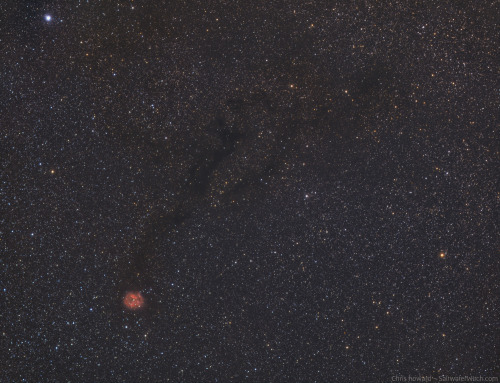
The Cocoon Nebula (IC 5146, Caldwell 19, Sh2-125) is a combination reflection and emission nebula in Cygnus, and the long trail of dust is the dark nebula Barnard 168. (In an emission nebula, the intense radiation from one or more stars causes the surrounding gases—hydrogen, oxygen and other gases, to release energy and emit their own light, e.g., the hydrogen itself is lit up. In a reflection nebula, the light from one or more stars reflects off or shines through the surrounding interstellar dust, hydrogen, and other gases. So, there’s a bit of both going on in the Cocoon). The last time I captured the Cocoon Nebula, a little over a year ago, I used the 800mm Newt and IC 5146 (the circular red region) filled most the whole center part of the image. This time, with the SpaceCat’s wider field of view, 250mm focal length, I framed the area to be able to capture the long stream of interstellar dust catalogued as B 168. The Cocoon, IC 5146 is about 4000 lightyears away, and the central star illuminating the surrounding gas and dust is a newly-formed star, maybe only be 100,000 years old (compare to our star: the Sun is around 4.6 billion years old). Imaging Notes: 90 x 180-second Red, Green, Blue filters (Astronomik Deep Sky RGB), ZWO ASI1600MM-Pro monochrome camera running at -10C, ZWO AM5 EQ mount, William Optics SpaceCat 51 apochromatic refractor, ZWO ASI290MM guide camera with OAG.
My astro blog: https://SaltwaterWitch.com
September 25, 2022
Beautiful skies last night, mostly clear, and no moon, the...
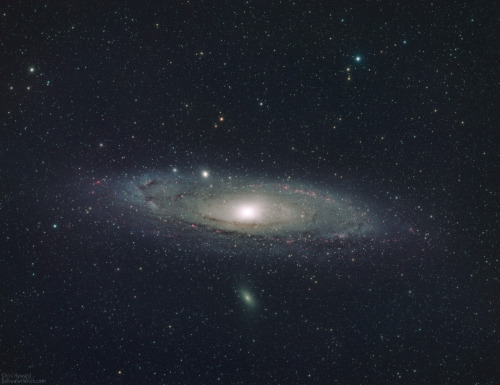
Beautiful skies last night, mostly clear, and no moon, the perfect night for broadband color with separate RGB filters + Hydrogen-alpha, and I went after one of the finest northern hemisphere color targets. Andromeda (M31) is one of our galactic neighbors at only 2.5 million lightyears away. Our own galaxy, the Milky Way, consists of as many as 400 billion suns, while Andromeda may have as many as a trillion suns. M31 is about 152,000 light-years across, and the Milky way is a bit under 90,000 lightyears. We’re both good-sized barred spiral galaxies. Stick around for a few billion years and you can watch us collide and form one massive galaxy. Notes: 51 x 120-sec Red, 53 x 120-sec Green, and 56 x 120-second Blue filter (Astronomik Deep Sky RGB filters), 60 x 180-second Hydrogen-alpha (Astronomik 6nm), ZWO ASI1600MM-Pro monochrome camera running at -10C, ZWO AM5 EQ mount, William Optics SpaceCat 51 apochromatic refractor. My astro imaging here: https://SaltwaterWitch.com
September 17, 2022
NGC 6888, the Crescent Nebula in Cygnus, is mostly made up of...
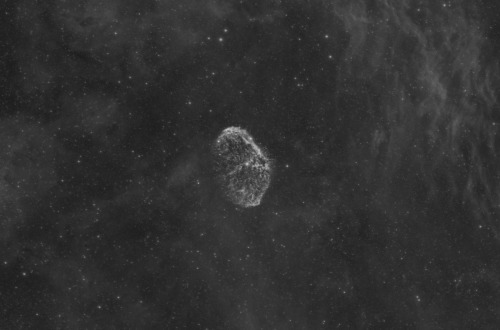

NGC 6888, the Crescent Nebula in Cygnus, is mostly made up of ionized hydrogen with a filmy envelope of oxygen (not present in this Ha-only data). Its longest side spans about 25 lightyears, or about 235 trillion kilometers (146 trillion miles), which at only 5000 lightyears away, is a pretty good-sized deep sky object. I spent the entire night capturing hydrogen-alpha data, over 60 subs, 53 of which I used in this stack. I will come back on another night to capture the OIII data. Notes: William Optics SpaceCat51 apochromatic refractor, ZWO ASI1600MM-Pro monochrome camera cooled to -10C, 53 x 300-second subframes (about 4.5 hours of data) stacked in DSS, ZWO AM5 EQ mount, ASIAir Plus controller. (I ordered the ASIAir early August—backordered, and it arrived a couple weeks ago. This is only my second time out with the Air, and I can already see this being be my away-from-home controller).
September 16, 2022
Off to shoot the Wizard - NGC 7380 is an open star cluster in...
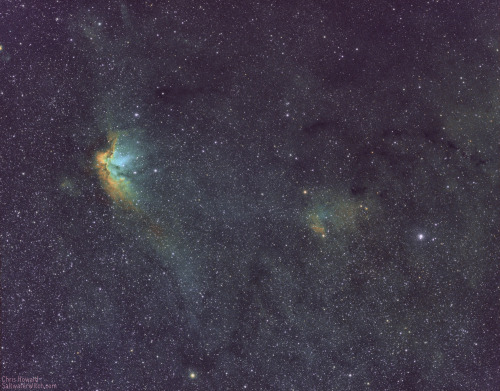
Off to shoot the Wizard - NGC 7380 is an open star cluster in Cepheus, surrounded by the bright emission nebula Sharpless 142 (Sh2-142, center, left), but we all know it as the Wizard Nebula. Why? Well, because it sort of looks like a bent old dude with a pointy hat looking out over a vast expanse of nebulosity, loops of dark interstellar dust, and a spread of hot stars bathing everything in intense radiation, all of which could be mistaken for some sort of magical display. In other words, what a wizard might do. That’s my guess, anyway.
Last night was also my first night out with the ZWO ASIAir Plus (astro device controller), and because the Wizard has all three bands present to some degree, hydrogren-alpha, oxygen 3, and sulfur 2, I thought I would try something new: shooting 10 subs for each filter, running autofocus for each set, and then looping through each set of three filters three times. This way I would end up with 30 sub frames for each over the course of one night, a reasonable amount of data. This would also allow me to see how the meridian flip went, how well the autofocus routines work, and more. Note: with the 3nm Antlia Pro narrowband filters, each autofocus run takes about 7 minutes, with a set of 20 second exposures–the routine needs at least 20 just get enough stars to focus with these very narrow 3 nanometer filters.
It was also a cool mid-September night and with wind gusts and “poor seeing” according to the Clear Sky Chart, the guiding with the ZWM AM5 wasn’t outstanding, but good enough for 300-second exposures, never straying too far above an arcsecond.
Here’s the combined narrowband result in SHO, the Hubble Palette, where Sulfur is mapped to Red, Hydrogen to Green, and Oxygen to Blue in RGB colorspace.
September 7, 2022
I’m hoping for some clear skies tonight, enough to test...
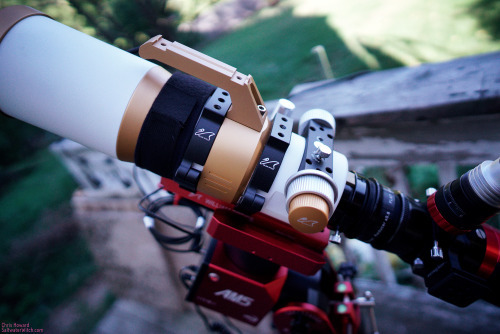
I’m hoping for some clear skies tonight, enough to test out the ZWO AM5 with my trusty William Optics GT81 and the ZWO ASI071 cooled color camera. It’s a beautiful fall day out there right now, at quarter after 5pm, but I don’t think this is going to last into the evening.
September 6, 2022
The California Nebula (NGC 1499) in the constellation Perseus....
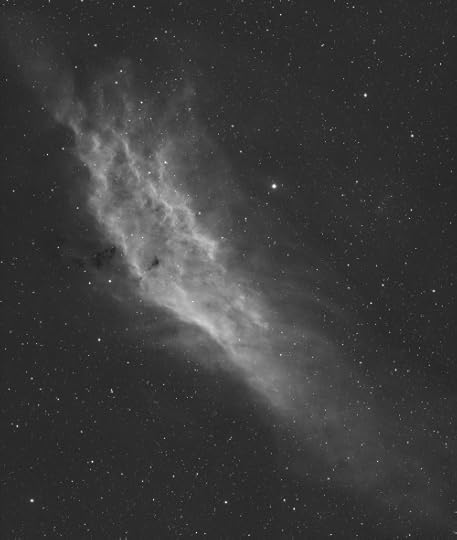
The California Nebula (NGC 1499) in the constellation Perseus. Imaging notes: 3nm Antlia Pro hydrogen-alpha filter, William Optics SpaceCat 51 Apochromatic refractor, ZWO ASI1600MM-Pro monochrome camera.
September 5, 2022
A shot of my backyard last Friday. It was nice and clear, and I...
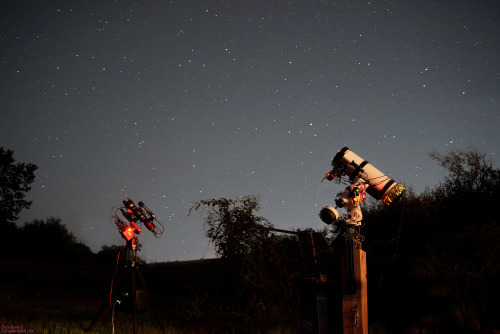
A shot of my backyard last Friday. It was nice and clear, and I ran both imaging systems, the 250mm monochrome camera and narrowband (NGC 281, Pacman Nebula in Cassiopeia), and the 800mm with filtered RGB color (M33, Triangulum Galaxy). Equatorial mounts: #ZWOAM5 and EQ6R-Pro
August 30, 2022
I finished up the Lobster Claw Sunday night with some 3...
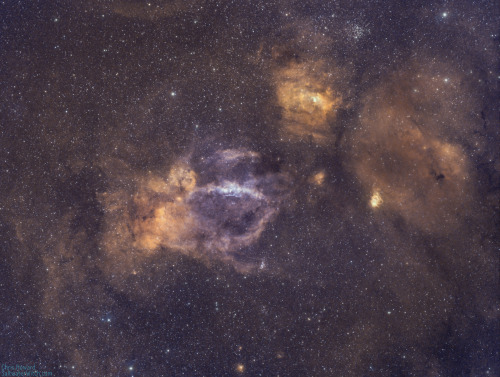
I finished up the Lobster Claw Sunday night with some 3 nanometer Oxygen3 data. The Lobster Claw (Sh2-157), the Bubble Nebula, and so much more, extending over the border from Cassiopeia into Cepheus. The squarish bright region, Sh2-157a, at the joint of the top bluish arc of the Claw is a denser emission structure surrounding the Wolf Rayet star WR-157. The Bubble Nebula is middle top (NGC 7635, Sharpless 162, Caldwell 11), and the bright emission region below and to the right is NGC 7538. That cluster of stars above the Bubble Nebula is Messier 52 (M52). The Lobster Claw Sh2-157 is about 8000 lightyears away.
August 28, 2022
Very foggy this morning, and water in the air clings in...
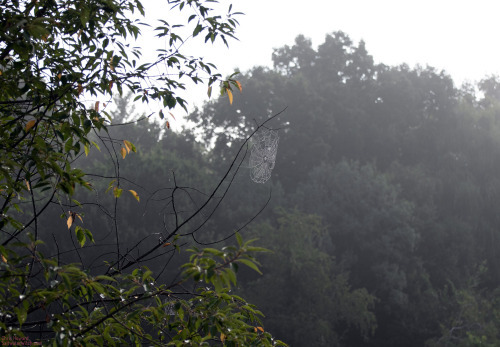
Very foggy this morning, and water in the air clings in thousands of tiny beads along the strands of a spider’s web. Fog conceals most things and reveals others. (Nikon D750, 300mm)
August 21, 2022
Just doing a little weekend astrophotography. Actually,...
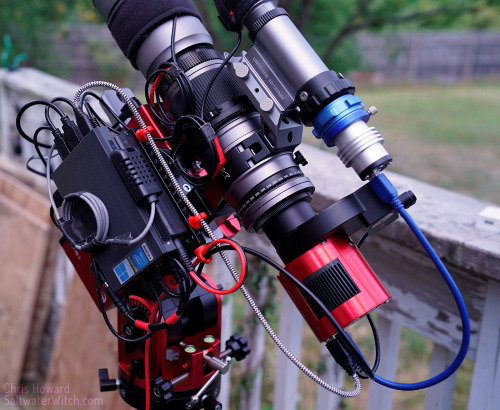
Just doing a little weekend astrophotography. Actually, I’m just taking pictures of my gear because the evening weather is foul. But if it was clear, this is what I would be using to capture the night sky.



